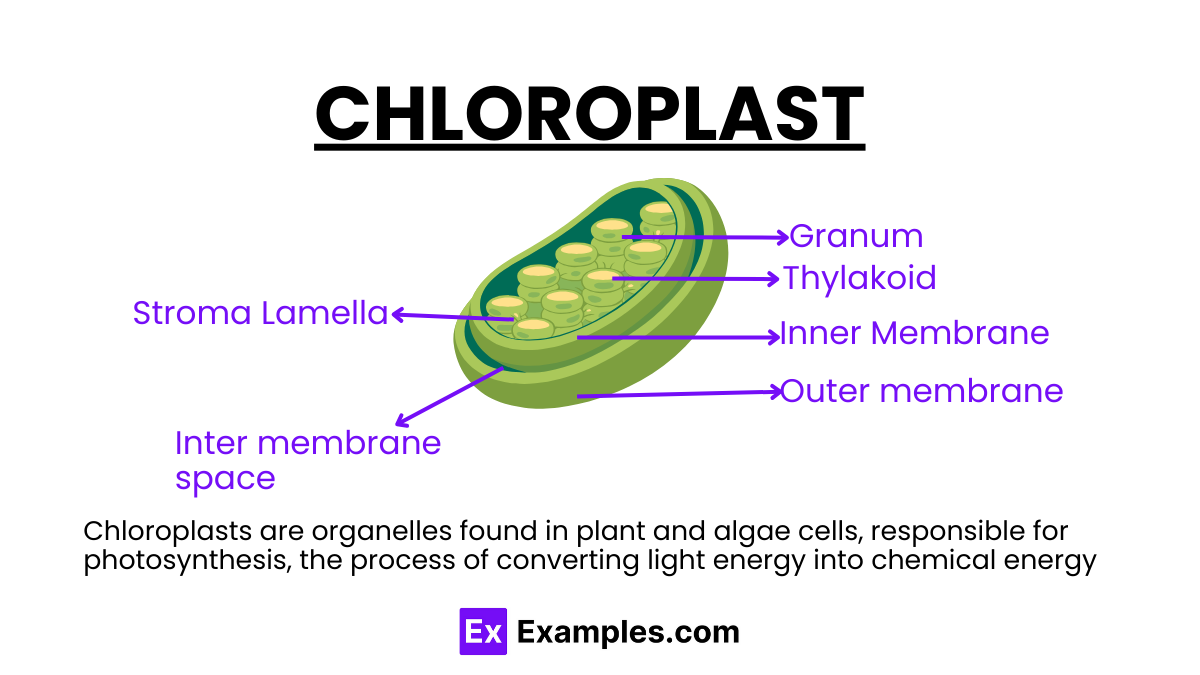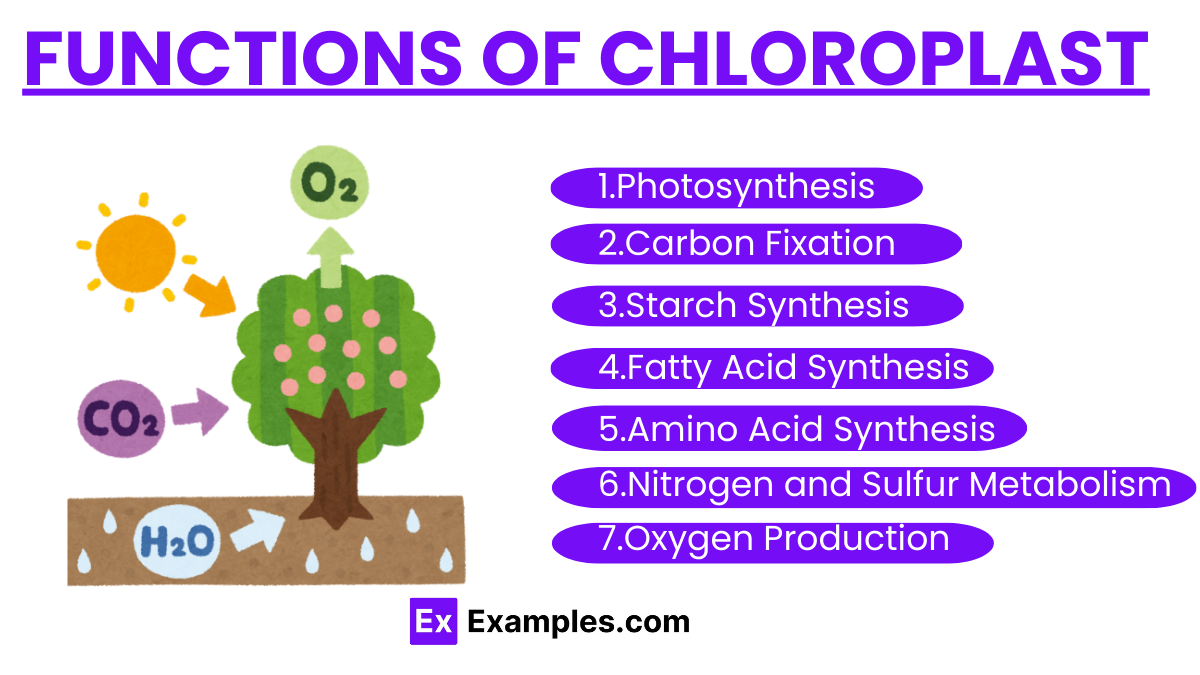Which of the following structures contains chloroplasts?
Animal cells
Plant cells
Fungal cells
Bacterial cells


The green essence of life with our comprehensive guide on chloroplasts, nature’s own solar panels. These microscopic powerhouses are found in the cells of green plants and algae, playing a critical role in photosynthesis, the process that converts light energy into chemical energy. Through vivid examples, this guide illuminates the structure, function, and significance of chloroplasts in sustaining life on Earth. Discover the fascinating world of chloroplasts and how they orchestrate the flow of energy through ecosystems, fueling the planet’s diverse forms of life. From the lush leaves of a towering tree to the simple beauty of green algae, chloroplasts are the unsung heroes of our natural world, embodying the intricate relationship between sunlight and life.
Chloroplasts are specialized organelles found in the cells of plants and some algae. They are crucial for the process of photosynthesis, the biochemical process by which light energy is converted into chemical energy, thereby providing the primary energy source for the plant and, by extension, the ecosystems dependent on them. Here are the key aspects of chloroplasts.
The structure of chloroplasts is complex and highly specialized to facilitate their role in photosynthesis. Each chloroplast is encased in a double-membrane envelope and contains a third internal membrane system, along with various components that work together to convert light energy into chemical energy. Here’s a breakdown of the key structural elements:

Chloroplasts are critical organelles found in the cells of plants and some algae, essential for photosynthesis, the process by which light energy is converted into chemical energy. Their functions go beyond photosynthesis, contributing to various aspects of plant metabolism and stress responses. Here’s a detailed explanation of their functions:
Chloroplasts are organelles associated with photosynthesis, and they are typically found in plant cells and some algae but not in animal cells. Here are the key points regarding the concept of chloroplasts in animal cells:
A chloroplast is a type of organelle found in the cells of plants and some algae. It’s primarily responsible for photosynthesis, the process by which light energy is converted into chemical energy, fueling the plant’s activities and growth.
Chloroplasts work by capturing light energy through pigments like chlorophyll, located in their thylakoid membranes. This energy is used in light-dependent reactions to generate ATP and NADPH, which are then used in the Calvin cycle (in the stroma) to fix carbon dioxide into organic sugars.
Chloroplasts are found in the cells of green plants and some algae. Specifically, they are abundant in the leaves of plants, where most photosynthesis takes place, but can also be found in other green parts of the plant.
Most plants have chloroplasts because they rely on photosynthesis for energy. However, some parasitic or non-photosynthetic plants may lack chloroplasts because they obtain their nutrients from other sources.
Yes, chloroplasts can move within plant cells. Their movement is often in response to light, optimizing the absorption of light for photosynthesis (photorelocation) or protecting chloroplasts from damage under intense light conditions.
The number of chloroplasts per cell can vary widely, from one in some algae to hundreds or even thousands in the cells of higher plants, depending on the species, cell type, and environmental conditions.
Chloroplasts and mitochondria are both energy-converting organelles in cells, but they have different functions and origins. Chloroplasts are involved in photosynthesis, converting light energy into chemical energy, and are found in plants and some algae. Mitochondria, found in nearly all eukaryotic cells, including plants and animals, are responsible for cellular respiration, converting chemical energy from food into ATP, a form of energy that cells can use.
Chloroplasts are believed to have originated from an endosymbiotic event, where a eukaryotic host cell engulfed a photosynthetic cyanobacterium. Over time, the cyanobacterium became a permanent, symbiotic organelle within the host cell, evolving into what we now recognize as a chloroplast. This process is supported by the presence of their own DNA and ribosomes in chloroplasts.
The main pigments found in chloroplasts are chlorophyll a and chlorophyll b, which absorb light primarily in the blue and red wavelengths. Carotenoids, another group of pigments, absorb light in the blue-green wavelengths and provide photoprotection for the chloroplast.
Chloroplasts cannot be passed from one organism to another in the way infectious agents might be. However, through processes like horizontal gene transfer, some of the genetic material originally present in chloroplasts has been transferred to the nuclear genome of the host plant over evolutionary time scales.
Chloroplasts are pivotal organelles exclusive to plant cells and some algae, serving as the site of photosynthesis. They transform sunlight into chemical energy, fueling plant growth and producing oxygen vital for life on Earth. Characterized by their double membrane, chlorophyll-containing thylakoids, and the ability to self-replicate, chloroplasts underscore the interconnectedness of life, highlighting the crucial role plants play in sustaining ecological balance.
Text prompt
Add Tone
Structure of Chloroplast
Functions of Chloroplast
Which of the following structures contains chloroplasts?
Animal cells
Plant cells
Fungal cells
Bacterial cells
What is the primary function of chloroplasts?
Cellular respiration
Photosynthesis
Protein synthesis
Lipid production
Chloroplasts contain a pigment called:
Hemoglobin
Myoglobin
Chlorophyll
Keratin
In which part of the chloroplast does the light-dependent reaction of photosynthesis occur?
Stroma
Thylakoid membrane
Cytoplasm
Mitochondria
The fluid-filled space inside the chloroplast surrounding the thylakoids is called the:
Matrix
Cytosol
Stroma
Nucleoplasm
What molecule is produced as a byproduct of photosynthesis in chloroplasts?
Carbon dioxide
Oxygen
Nitrogen
Methane
Chloroplasts are thought to have originated from:
Prokaryotic cells
Eukaryotic cells
Viruses
Fungi
Which of the following is NOT found in the chloroplast?
Thylakoids
Stroma
Mitochondria
Grana
During the Calvin cycle in the chloroplast, carbon dioxide is:
Released
Fixed into glucose
Converted into oxygen
Split into water
What structure connects the grana in chloroplasts?
Stroma
Lamellae
Matrix
Cytoplasm
Before you leave, take our quick quiz to enhance your learning!

